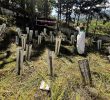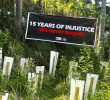The incident prompted Patufa, led by its municipal chapter United Farmers of Sta. Cruz, to ask the 39th IB to leave their village. Soldiers were still staying in the Coronon barangay hall at the time but they were roving in surrounding sitios of Malusing and Patulangon. The 39th IB was forced to leave their community in August 2006 because of the group’s demand.
But in July 2008, the 39th IB returned and started encamping in Barangay Tuban in Sta. Cruz. On November 11 of the same year, the soldiers went back to Malusing and stayed there until March 2009. They stayed in an unoccupied house in the community of civilians.
Within four months, soldiers were visiting leaders of Patufa, asking for the list of their members and other leaders. Formed in 1995, Patufa already had 105 members from sitios Malusing and Patulangon.
By February 2009, the 39th IB started organizing residents for its Barangay Defense System, launching a February 24 march rally with 300 recruits from 18 Sta. Cruz villages.
In May 2010, Gormi Malasugi, a peasant from Sitio Langan, Barangay Coronon,was on his way home from Coronon Poblacion when he met the soldiers belonging to the 39th IB. Malasugi was allegedly mauled. He was badly beaten that he spewed blood as a result. Malasugi was a bit drunk when he met the soldiers coming from a military operation.
After the incident, Malasugi had been hiding in the farm, fearing for his life. He reportedly asked for help from Sta. Cruz Mayor Joel Ray Lopez but there was no action from the local government on his case.
Marietta Bao, Patufa spokesperson, said people were not comfortable with the presence of the military in their area.
“I don’t know what OB list is, but we’re really afraid,” Bao, 51, said. She said the residents in her sitio were restless and worried. “We really wanted them (the military) to leave our community, and not to live with us, civilians,” she said.
Marciano said they are afraid they might be caught in the crossfire in the conflict between Communist guerillas and the government forces.
“Our livelihood will definitely be affected,” he said. “It already happened before. The military prohibited us from going to our farms after they were harassed by the NPAs.
Patufa believed this was part of the military’s ploy to destroy their organization. They learned that in North Cotabato, the military allegedly had a list of 45 names — mostly peasants — in its OB list and one of those on the list was already killed.
“They wanted to destroy the members’ trust on each other,” a local organizer said. “In Sta. Cruz, the military was not able to break the unity of residents in sitios Malusing and Patulangon,” he said.
The Pasaka Confederation of Lumads in Southern Mindanao said the military is carrying out Oplan Bantay Laya (Freedom Watch) II, a counterinsurgency plan of the Arroyo government which is nearing its June 30 deadline.
Progressive organizations have blamed this operational plan to the death of more than a thousand of its members and leaders nationwide since President Gloria Macapagal-Arroyo rose to power in 2001.
To meet the OBL deadline, the government has deployed more troops in areas believed to be NPA strongholds, resulting to the rise in the cases of human rights violations.
At least 10 military battalions operate in Southern Mindanao, including the 71st IB from Central Luzon and the 84th IB which recently landed in Tagum port. These two battalions used to be under the 7th Infantry Division, once led by retired General Jovito Palparan, the army commander who earned the moniker “Butcher of Mindoro” because of the unsolved killings of political activists under his watch.
Patufa members and leaders planned to dialogue with soldiers and to challenge the local government to make a stand. They will also file a case against the military in the Commission on Human Rights and to expose and oppose the military encampment in civilian communities. ( Marilou Aguirre-Tuburan/davaotoday.com)










